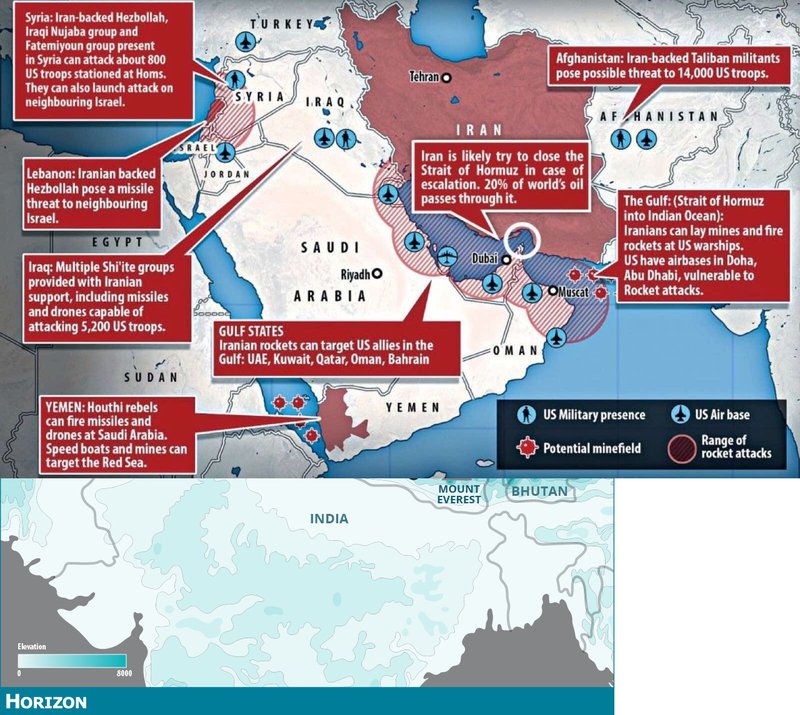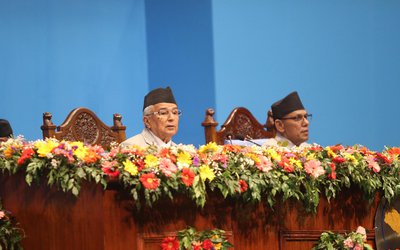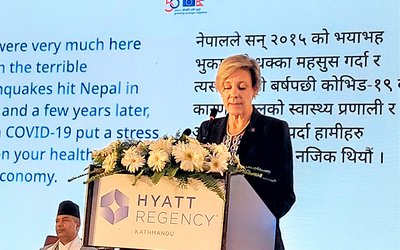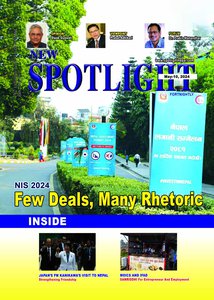
President Donald Trump’s address to the nation on 8th January clearly avoids escalating the US-Iran pandemonium, but with more sanction and no to Nukes. Both countries tried to diffuse a crisis over the US killing of Gen Qassem Soleimani, retaliated by Iran with two dozen missiles on two American bases in Iraq. Though President Trump and the Pentagon claimed that no one was harmed the spokesperson for the US Central Command later stated that 11 individuals were injured. This can also be assumed as a response to the killing of an American contractor on Dec 29 in Iraq, when US air strikes killed two dozen members of the Iranian backed militia Kata’ib Hezbollah. Thousands of pro-Iranian demonstrators gathered outside the US Embassy in Baghdad and setting some buildings on fire. The Killing of Gen Soleimani and the retaliation by Iran and what is means for US-Iraq relation when the Iraqi parliament has asked the US forces to withdraw, Iran’s influence in the Middle East and other parts of the world, the European Union (EU), Russia and China’s attitudes towards the US and Iran. War could have cost the world enormous loss, but has given room for regional actors and extra regional powers enough room and space to find suitable response. Among others China, Israel and Russia reacted with admonition and ameliorate. The oil rich Middle East predicament does not just remain within the region but has impact in global economy, shortages of resources and energy. The South Asian region will face incomparable loss.
Geopolitical Realities
The global power US persuasion in the Middle Eastern region is fading and being replaced and influenced by great powers like Russia, Turkey, Saudi Arabia, Iran and China when Syria and Yemen are engrailed in conflict, while threat of instability in Lebanon, Iraq are persistent. Iran’s military strength, capabilities and sphere of influence is growing outside its borders with extra territorial operation capabilities by Quds Force of the Islamic Revolutionary Guard Corps (IRGC). The politics of the region have an effect on the steadiness of the world. There are international actors that have interests and desire to take advantage and want to find a way to exploit it. The important is the geopolitical story between the US and Iran with some periphery players.
Russia, a major power has demonstrated the capability to the interests in the Middle East by sending forces and sells arms and what their stake is in Iran. Russian has shown that they are a great power and protect their allies like Iran from the US. This is a strategy that they demonstrated and expressed in Syria though constraint does exist of over stretching its forces. Iran takes Russia as an occupation force in WW II so there is a limit to how Russia can get involved in Iran. Lately, Russia attempted to use the airbase in Iran to strike in Syria caused reaction by the Iranian.
China, whose strategy is peaceful rise can combine transactionalism with some opportunism with strategic exploitation when some powers are weaker and how that plays with Iran is that they will work together and will continue to be buyers of Iranian oil. They will lend a hand to Iran to dodge sanctions customarily for China’s own benefits. Chinese will not dispatch troops or defend the Iranians in confrontation but would like to sell arms to Iran as a helping hand. The recent Naval drill between China, Iran and Russia was symbolic and not that Beijing and Moscow would send troops or be a bigger associate. At the same time Iran wants to stand on their own and be their own independent power so that they will not have too many obligations to the great powers.
Saudi Arabia and other Gulf states were robustly lobbying campaign deal not to see Iran as a nuclear power and Iran to abandon or back off. They fancy for maximum pressure but not maximum tension. The possibility of regional dispute is there, the Saudis the Emirates’ and other Gulf states have been signaling to the Iranians and the US that they want tensions to go down and not another regional conflict as it would bring about lot of impairment to their economies, political system and others. The desire of sanctions to remain is visible but without military tensions.
Israel is not anxious regarding the Iranian reprisal as they have been accessible with Iranian targets in Syria, Iraq and Lebanon with the combination of domestic politics with the election in March not to see too much instability and acknowledgement reality in the ground as the US is an primitive military power that can do better than the Israelis and would be happy to see the Americans to their job.
Terrorist militant group designated by the UN the Islamic State of Iraq and Levant (ISIL) also called Islamic State of Iraq and Syria (ISIS) officially known as the Islamic State (IS) movement and the Caliphe is another factor in the Middle East that gained prominence in 2014 when the Iraqi forces were driven out of the key cities in its Western Iraq offensive and the Sinjar massacre. IS conducted ground attacks on both government forces and opposition factions in Syria in 2015. The international coalition led by the US intervened against ISIL in Syria and Iraq, which was soon followed by small scale Russian intervention in Syria. The international attempt led to the group loosing grounds like Mosul in 2017 and the leader Abu Bakr al-Baghdadi who killed himself on 27th Oct 2019. The military campaign is limited but not over.
The Strait of Hormuz and the Suez Canal are very vital in the Arabian Peninsula for global oil trade and how damaging it would be on the disruption of oil flow. On the eastern side of the Arabian Peninsula is the Arabian Sea that is connected to the Mediterranean by the Red Sea on the west which runs amid the peninsula to north of Africa and connects the Mediterranean Sea through the Suez Canal. The east side of the Peninsula the Arabian Sea flows into the Gulf of Oman that is connected to the Persian Gulf. Connecting these Gulfs is the 39 km wide Strait of Hormuz. The Strait is bounded on either side by Iran, Oman and the United Arab Emirates. Three billion liters of Oil, which is about 21% of the daily petroleum consumption of the world as well as 1/3 of the all of the sea transited oil and ¼ of Liquefied Natural Gas (LNG) travels through the Strait of Hormuz. Any confrontation within the Strait has the probability to lock up transit and or at worst spark conflict between countries. See Figure 1
Asymmetric warfare and cyber warfare is increasing.

Figure 1 US and Iran’s capability in the Arabian Peninsula
Persuasion of Iran’s Interest
2020 will observe election in both Iran and the US. These elections are domestic matters but have international impact. The next person in the oval office could either bring opportunity or risk. Iran lies crossroads of the Islamic world and centrally located linking the Middle East with the Caucasus and Central and South Asia. Iran supports the Hezbollah in Lebanon, Assad regime in Damascus and the Shiite led government in Iraq. 4th largest oil reserves and the largest natural gas reserves are in Iran.
The 20th century saw the British, Russian, and the US interests competing to control Iran’s strategic geographic location and its noteworthy energy assets. This modern day dependence on energy capitals has upshot in Iran’s converge on securing the Strait of Hormuz and the intensifying authority and control over the Persian Gulf to secure its core territories.
Iran’s admission that it accidentally shot down the Ukrainian airlines raises various domestic issues for Teheran and ovation in Washington. The peaceful protests in the streets of Teheran are bringing about domestic confusion when international obligation was to receive priority. Donald Trump tweets on 11th Jan “To the long-suffering people of Iran: I’ve stood with you since the beginning of my Presidency, and my Administration will continue to stand with you. We are following your protests closely and are inspired by your courage’.
In the de-escalations stage and to watch it go ahead is the combination of a proxy theaters like Syria and Iraq where US troops are still stationed and Iranian proxies are still active waiting to see if there are flare ups and how that will play up and the other thing is to see what will happen with the Iranian Nuclear program development though Iran are willing to go forward.
Impact in South Asia
The South Asian region that compromise more than a fifth of world’s population and contributes to more than 15 percent of its economic growth came out with similar statements to prevent the escalating conflict through negotiations and that confrontation would alarmed world peace. Pakistan’s initial reactions were observed to be in favor of Iran. Afghanistan and Pakistan share immediate borders with Iran and the likely hood of US-Iran confrontation would spill over in South Asia. In 2018 about 76% of the crude oil was transported to Asia and consumed mainly by five countries China, India, Japan, Singapore and South Korea.
India which has cordial relationship with both US and Iran spoke to both Mike Pompeo and Javed Zarif and voiced India’s concern over the escalating tensions in the Gulf region.
Afghanistan which hosts twelve thousand US and Allies troops across Iran’s eastern borders with Afghanistan has been placed in unsteady circumstances and could be targeted by Groups supporting Iran. The peace talks with the Taliban would be affected.
Pakistan that hold the 2nd largest Shia population in the world mentioned “Respect for sovereignty and territorial integrity are the fundamental principles of the UN charter, which should be adhered to. It is also important to avoid unilateral actions and use of Force”. The assassination of General Soleimani was condemned by Pakistan’s Minister though the Pakistani positioned changed after General Bajwa the Chief of the Army and Pompeo’s telephonic conversation. All the stalled military education and training together with the military assistance of $ 2 billion which was withheld would resume. There is an assumption that Pakistan fears a sectarian if it sided with the US.
The tensions and the destabilizing consequences are of great concerns especially to Afghanistan, India and Pakistan and to other South Asian nations as well for reasons of security, economics and diplomacy. Iran that provides arms and human resources has proxy partners in nation states that is capable of carrying out reprisals on US forces. It is worrisome that the hostility would give room for the IS to regroup given the occurrence of terrorist’s attacks in Jammu and Kashmir, India, bombing in Sri Lanka and Bangladesh. The Iranian proxies in 2012 attack on an Israeli diplomat vehicle in India is an example. The risk of economic interests is present with extensive commercial ties to the region. The dependence of energy resources from the Middle East would add to the crisis. Two third of India’s oil imports and half of its liquefied natural gas imports pass through the Strait of Hormuz, which could have a serious bearing to Nepal’s supply as well.Maldives and Bangladesh had significant numbers joining the IS as foreign fighters.
Nepal has approximately more than seven million citizens living and working in the Middle East and their safety and security causes great concerns to the Nepali government. The oil prices will rise and the shortage would create panic due to deficiency in India. 31.3% of the GDP the backbone of Nepal’s economy is supported by remittance and will impact the already fragile economy. The 40% unemployment youth would increase creating internal challenge to law and order situation. Home land security risks will go up and the threat of Iran’s sympathizers connections in Nepal to target US targets and under cover financial and other activities cannot be ruled out.
Iran’s demographic and economic pressure may affect its ability to influence regional dynamics in South Asia with that have affected its energy sector-oil production and export have declined dramatically impacting the finance sector.
Conclusion
2020 emergence with primarily six predicament in the forefront, if the world is competent to manage nuclear proliferation, bringing all along to be once again part of climate change, re-establish confidence and reliance in the United Nations system, US-Iran relationship which has been strenuous for the last four decades, global counter terrorism fight and finally, Great power relations where both the US competitors Russia and China seek to grasp the US taken down. The full response will unfold in the coming months and years.
The national security team of the US has brought forward three pillars economic pressure by denying Iran funds to finance terror, diplomatic isolation by working together with allies and enhanced military deterrence by killing Soleiman. The goal is in two folds; to deprive resources it needed to disseminate destructive behavior around the world and second want Iran to perform like a customary nation.
The Quds Forces will orchestrate a regional campaign of asymmetric attacks across the Middle East and possibly in South Asia and other parts of the world. The IS will have an opportunity to reorganize. The goal of both the IS and the Quds will be to disrupt, threaten, and restrict US and Allies operations and their presence. Russia will limit the potential for escalating between Iran and the US rather than back Iran unconditionally.
When the US desires more involvement by the EU or the North Atlantic Treaty Organization (NATO) forces, Russia is looking for ending confrontation with the EU and signing a peace agreement and EU agreeing not to expand eastwards end NATO and US domination of European affairs. It is a big diplomatic victory for Russia and a good move as Europe needs to have its say in world affairs. Will the EU be in the same page and cooperate with the US? The trends to watch are the US military prioritizing strategy in the Middle East over great power competition with China and Russia.
The likelihood of non-state actors being persuaded and operated by the IS or the Quds Force for terrorists related activities cannot be ruled out.
The position of the UN would provide more leverage to the other nations that have limited military strength when it comes to rights and sovereignty and territorial integrity of nations with great powers that insist and pursuance their policies and philosophies.
While the possible catastrophe of war has been forestalled for now Iran stay put as an obstinate challenge for the US. Both sides have managed to stay away from immediate escalation, the tension between Washington’s coercive Iran strategy and Tehran’s enthusiasm to act in response on the nuclear and regional fronts means the risks of conflict remain significant.

Binoj Basnyat
Basnyat is a retired Nepali Army Major General, is a political and security analyst
- Russian Aggression In Ukraine And Outcome In South Asia
- May 05, 2022
- The Nepal Opportunity 2079
- Feb 04, 2022
- Change Of Guards Part -II
- Jan 07, 2022
- How India Lost Post 12-Point Agreement
- Dec 29, 2021
- US Troops Withdrawal From Afghanistan And Implication To South Asia
- Jul 31, 2021
















